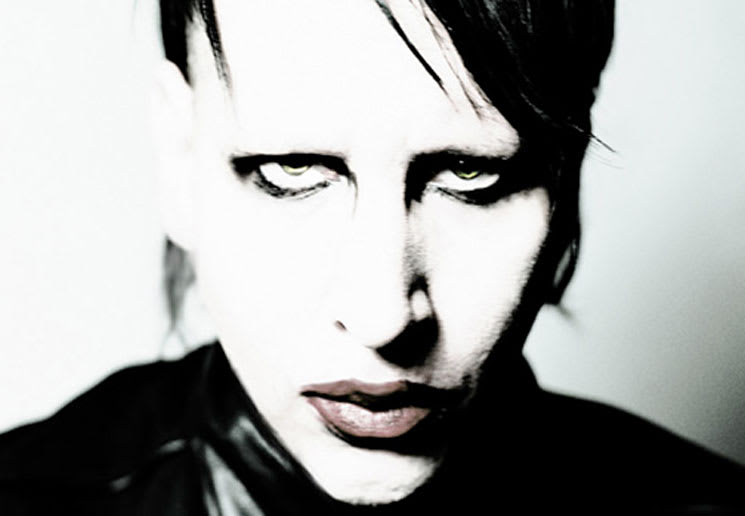You might think Marilyn Manson would be done with trying to shock people.
As the leader of the industrial-glam-rock band of the same name, he was once America's biggest pop culture bogeyman — an actual member of the Church of Satan preaching against God, guns and government. Somehow (it being the 1990s), he managed to get into regular rotation on MTV with this. Then, at this height of his influence, he got unfairly connected to the 1999 Columbine school massacre and never fully recovered.
For a while, he was a tabloid star instead, engaged to Rose McGowan, married and quickly divorced to pin-up star Dita Von Teese then in a relationship with Evan Rachel Wood when she was 20 and he was 38. More recently, he's been making headlines for stumbling across stages (and, indeed, falling off of them), unable to perform. The man obsessed with Bowie could use another reinvention.
But then, the night before the U.S. election, the 48-year-old singer dropped a NSFW video preview of his new album, SAY10, in which he beheads a figure in a suit and red tie with tiny hands while screaming, "Cash is the poor man's money" and "You say God, I say Satan!"
So no, it seems Manson is not going quietly: Rather, he's doubling down.
SAY10 is Manson's tenth studio album. While the best introduction to his work is to watch his grotesque music videos, where the full force of his artistic worldview is on display, once indoctrinated there are several dark rock'n'roll classics to further twist your mind. Below, find a list of his best work in Exclaim!'s Essential Guide to Marilyn Manson.
Essential Albums:
4. Smells Like Children EP
(1995)
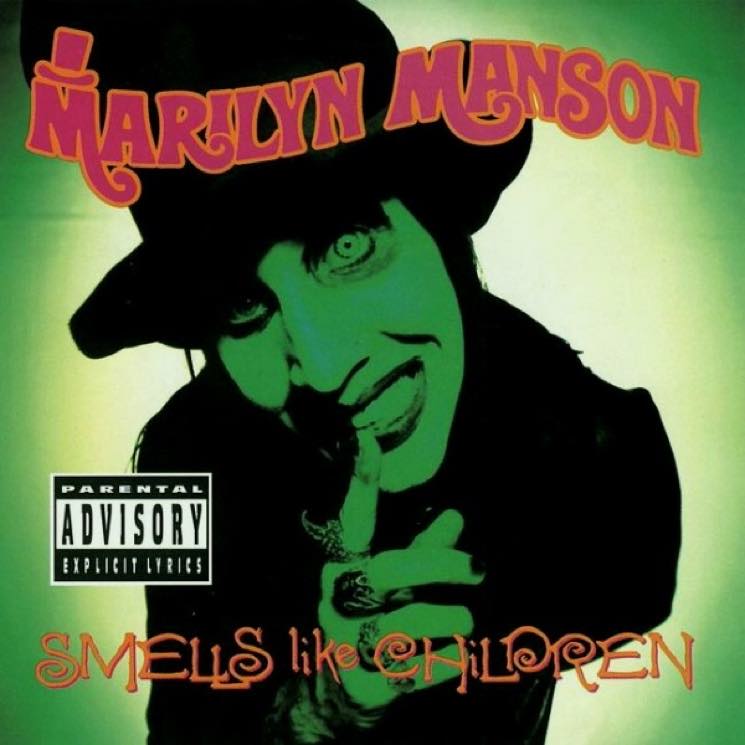
This is Manson at his absolute weirdest — and that's saying something. Smells Like Children is Willy Wonka meets Texas Chainsaw Massacre; merry-go-rounds and acid trips; and a Eurhythmics cover that would break these freaks on alternative rock radio. This Spooky Kids-era collection, produced by Trent Reznor, was poorly received on release but proves a much more interesting document of the early years than 1994's debut album, Portrait of an American Family.
The eerie earworm "Sweet Dreams" aside, the sounds here are completely unhinged: spoken word; instrumentals; found audiotapes. But lyrically, Manson is on-point with his vulgar and scathing critiques of the moral majority, and their child abuse and neglect wrapped in righteousness. ("Kiddie Grinder" sums the mood up nicely.)
This is a gauntlet thrown.
3. Eat Me, Drink Me
(2007)

As 2003's swinging The Golden Age of Grotesque is the sound of the singer courting burlesque pin-up star Dita Von Teese, this followup is the soundtrack to their divorce. Despite the standard-issue shock rock titles ("You and Me and the Devil Makes 3," "They Said That Hell's Not Hot"), these songs are earnest and introspective, with Manson's vocals at their moodiest. You could almost bring this Manson home to mother. Almost.
Single "Heart-Shaped Glasses" literally bounces — his most pop track, while "If I was Your Vampire" is a rich and epic goth ballad. (Sample lyric: "We built this tomb together / I will fill it alone.") There's still plenty of guitar crunch and industrial-grade synths courtesy of co-producer Tim Sköld (of KMFDM), but Eat Me, Drink Me is lot less dense than his other albums. It's some welcome respite from his usual sonic assaults, and the last time he really threw listeners a curveball.
2. Mechanical Animals
(1998)

Bowie worship plus boobs. Manson scored his first number one album and his first Top 20 single by laying off the anti-religious tirades, reinventing himself as a glam rock star and hiring producer Michael Beinhorn (fresh off Hole's Celebrity Skin). Another concept album, this time heavily influenced by Diamond Dogs and Ziggy Stardust, Mechanical Animals is about two men who fall to Earth — one an actual alien called Omega and the other Manson himself, coming down from the high of his Antichrist Superstar fame.
Not that listeners noticed that, mind you. What sticks nearly 20 years later is the shiny production and sleazy swagger of "The Dope Show" and "I Don't Like the Drugs (But the Drugs Like Me)," which answers the question, "What if Rob Zombie remade Bowie's 'Fashion' and hired Dave Navarro to play on it?"
Sure, the lyrics here are mostly about substance abuse and pain, but it's by far the most fun Manson album to listen to. The cover art features Manson naked — an androgynous creature with prosthetic breasts, six fingers and Barbie-like non-genitals — which kept the record off many mall store shelves but didn't stop its overall commercial success. Seems like if you're going to write angry industrial anthems, screaming "Rock is Dead!" is far more palatable to the masses than "I am the God of Fuck." Go figure!
1. Antichrist Superstar
(1996)
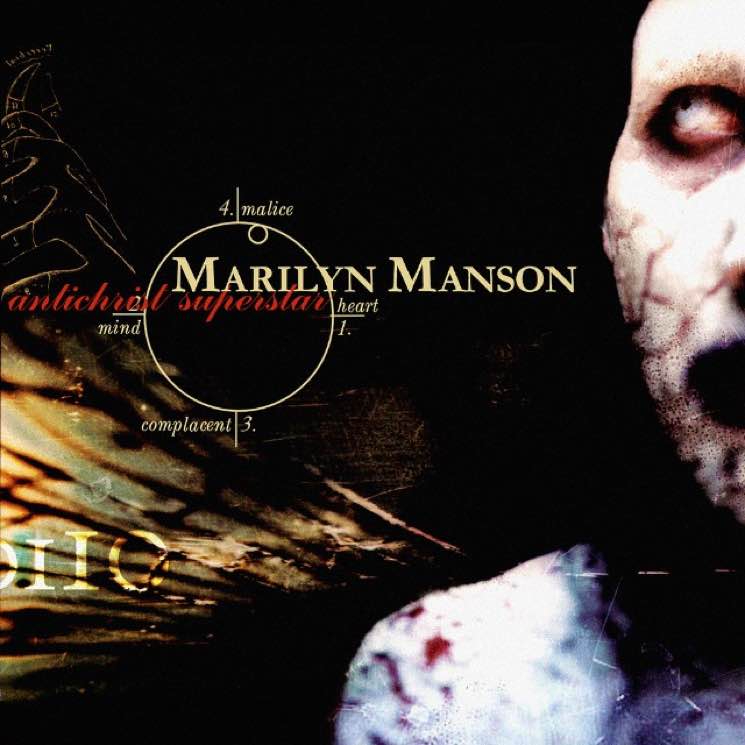
Peak Manson came with this 17-track, three-cycle, full-scale attack on power systems, cribbing from Nietzsche, that would attract the attention of protesting religious groups and mainstream radio programmers alike. You can still hear why.
Behold the hypnotic rat-a-tat rhythms, drop-tuned guitars and whisper-to-a-scream vocals of signature hit "The Beautiful People," which foreshadowed the rise of nu metal; the psychedelic masochism of "Tourniquet"'; and the piece de resistance, a cacophonous title track on which Manson plays a perverted preacher proselytizing Crowley-isms atop buzz-saw power riffs, backwards masking and Nuremberg rally-worthy chants of "Hail! Hail!"
Co-produced by his mentor Trent Reznor and featuring half the Nine Inch Nails camp at the height of their powers, this is a mission statement, masterfully executed. Shortly after this record, Senator Joseph Lieberman called Marilyn Manson, "perhaps the sickest group ever promoted by a mainstream record company." It stands as proof that there was a time when Manson was American culture's public enemy number one.
What to Avoid:
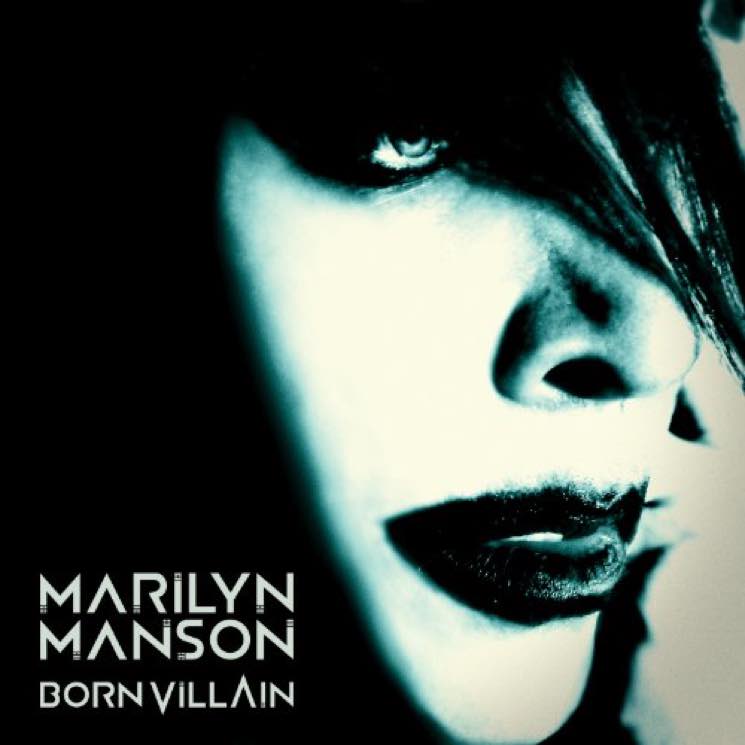
Manson's last three albums — 2009's The High End of Low, 2012's Born Villain and 2015's The Pale Emperor — feel relatively impotent compared to his opening salvos, retreading lyrical ground with less finesse and rehashing '90s industrial metal clichés that should have died with those wide-legged zipper pants.
The High End of Low has its moments of fury when it goes off on gun nuts, and The Pale Emperor offers a bluesier sonic palette, but Born Villain is a complete dud — it's like Manson is drunk at karaoke doing a bad Manson impression.
Further Listening:
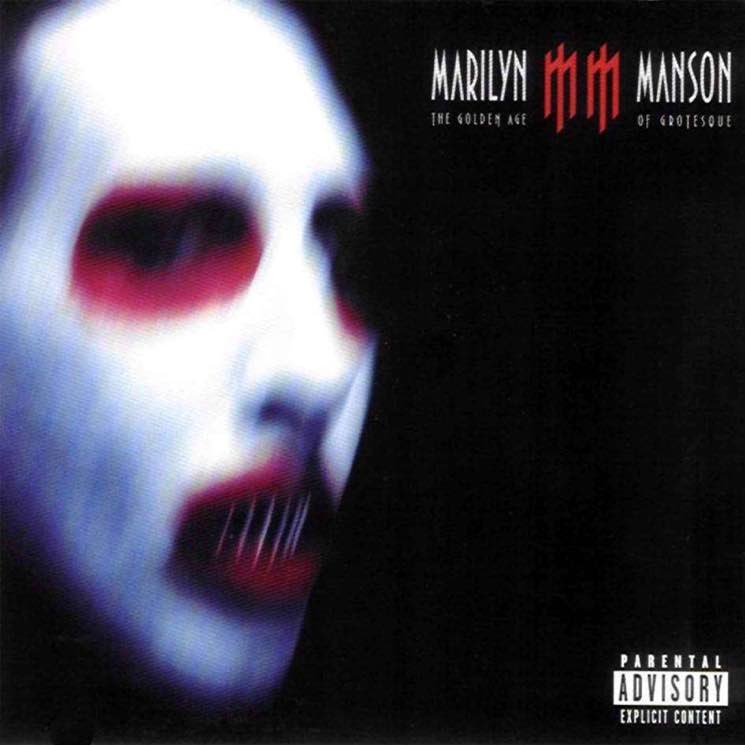
Two releases with too much filler to be essential still feature some of Manson's best tracks: 2000's Holy Wood (In the Valley of the Shadow of Death) contains the potent anti-authority anthems "The Love Song" and "The Fight Song," while 2003's The Golden Age of Grotesque offers the ripping "This is the New Shit" and catchy "mOBSCENE."
Scattered throughout compilations and soundtracks, Manson's random one-off covers reveal a more playful side to the Satanic prince: he's a Disney bedtime storyteller in "This is Halloween"; a gothic gangster in "Tainted Love"; and pop star on "Personal Jesus." Tacked at the end of his Remix and Repent EP (1997), a plaintive acoustic version of "The Man That You Fear" makes one wonder if an entire unplugged style album might be fascinating.
As the leader of the industrial-glam-rock band of the same name, he was once America's biggest pop culture bogeyman — an actual member of the Church of Satan preaching against God, guns and government. Somehow (it being the 1990s), he managed to get into regular rotation on MTV with this. Then, at this height of his influence, he got unfairly connected to the 1999 Columbine school massacre and never fully recovered.
For a while, he was a tabloid star instead, engaged to Rose McGowan, married and quickly divorced to pin-up star Dita Von Teese then in a relationship with Evan Rachel Wood when she was 20 and he was 38. More recently, he's been making headlines for stumbling across stages (and, indeed, falling off of them), unable to perform. The man obsessed with Bowie could use another reinvention.
But then, the night before the U.S. election, the 48-year-old singer dropped a NSFW video preview of his new album, SAY10, in which he beheads a figure in a suit and red tie with tiny hands while screaming, "Cash is the poor man's money" and "You say God, I say Satan!"
So no, it seems Manson is not going quietly: Rather, he's doubling down.
SAY10 is Manson's tenth studio album. While the best introduction to his work is to watch his grotesque music videos, where the full force of his artistic worldview is on display, once indoctrinated there are several dark rock'n'roll classics to further twist your mind. Below, find a list of his best work in Exclaim!'s Essential Guide to Marilyn Manson.
Essential Albums:
4. Smells Like Children EP
(1995)

This is Manson at his absolute weirdest — and that's saying something. Smells Like Children is Willy Wonka meets Texas Chainsaw Massacre; merry-go-rounds and acid trips; and a Eurhythmics cover that would break these freaks on alternative rock radio. This Spooky Kids-era collection, produced by Trent Reznor, was poorly received on release but proves a much more interesting document of the early years than 1994's debut album, Portrait of an American Family.
The eerie earworm "Sweet Dreams" aside, the sounds here are completely unhinged: spoken word; instrumentals; found audiotapes. But lyrically, Manson is on-point with his vulgar and scathing critiques of the moral majority, and their child abuse and neglect wrapped in righteousness. ("Kiddie Grinder" sums the mood up nicely.)
This is a gauntlet thrown.
3. Eat Me, Drink Me
(2007)

As 2003's swinging The Golden Age of Grotesque is the sound of the singer courting burlesque pin-up star Dita Von Teese, this followup is the soundtrack to their divorce. Despite the standard-issue shock rock titles ("You and Me and the Devil Makes 3," "They Said That Hell's Not Hot"), these songs are earnest and introspective, with Manson's vocals at their moodiest. You could almost bring this Manson home to mother. Almost.
Single "Heart-Shaped Glasses" literally bounces — his most pop track, while "If I was Your Vampire" is a rich and epic goth ballad. (Sample lyric: "We built this tomb together / I will fill it alone.") There's still plenty of guitar crunch and industrial-grade synths courtesy of co-producer Tim Sköld (of KMFDM), but Eat Me, Drink Me is lot less dense than his other albums. It's some welcome respite from his usual sonic assaults, and the last time he really threw listeners a curveball.
2. Mechanical Animals
(1998)

Bowie worship plus boobs. Manson scored his first number one album and his first Top 20 single by laying off the anti-religious tirades, reinventing himself as a glam rock star and hiring producer Michael Beinhorn (fresh off Hole's Celebrity Skin). Another concept album, this time heavily influenced by Diamond Dogs and Ziggy Stardust, Mechanical Animals is about two men who fall to Earth — one an actual alien called Omega and the other Manson himself, coming down from the high of his Antichrist Superstar fame.
Not that listeners noticed that, mind you. What sticks nearly 20 years later is the shiny production and sleazy swagger of "The Dope Show" and "I Don't Like the Drugs (But the Drugs Like Me)," which answers the question, "What if Rob Zombie remade Bowie's 'Fashion' and hired Dave Navarro to play on it?"
Sure, the lyrics here are mostly about substance abuse and pain, but it's by far the most fun Manson album to listen to. The cover art features Manson naked — an androgynous creature with prosthetic breasts, six fingers and Barbie-like non-genitals — which kept the record off many mall store shelves but didn't stop its overall commercial success. Seems like if you're going to write angry industrial anthems, screaming "Rock is Dead!" is far more palatable to the masses than "I am the God of Fuck." Go figure!
1. Antichrist Superstar
(1996)

Peak Manson came with this 17-track, three-cycle, full-scale attack on power systems, cribbing from Nietzsche, that would attract the attention of protesting religious groups and mainstream radio programmers alike. You can still hear why.
Behold the hypnotic rat-a-tat rhythms, drop-tuned guitars and whisper-to-a-scream vocals of signature hit "The Beautiful People," which foreshadowed the rise of nu metal; the psychedelic masochism of "Tourniquet"'; and the piece de resistance, a cacophonous title track on which Manson plays a perverted preacher proselytizing Crowley-isms atop buzz-saw power riffs, backwards masking and Nuremberg rally-worthy chants of "Hail! Hail!"
Co-produced by his mentor Trent Reznor and featuring half the Nine Inch Nails camp at the height of their powers, this is a mission statement, masterfully executed. Shortly after this record, Senator Joseph Lieberman called Marilyn Manson, "perhaps the sickest group ever promoted by a mainstream record company." It stands as proof that there was a time when Manson was American culture's public enemy number one.
What to Avoid:

Manson's last three albums — 2009's The High End of Low, 2012's Born Villain and 2015's The Pale Emperor — feel relatively impotent compared to his opening salvos, retreading lyrical ground with less finesse and rehashing '90s industrial metal clichés that should have died with those wide-legged zipper pants.
The High End of Low has its moments of fury when it goes off on gun nuts, and The Pale Emperor offers a bluesier sonic palette, but Born Villain is a complete dud — it's like Manson is drunk at karaoke doing a bad Manson impression.
Further Listening:

Two releases with too much filler to be essential still feature some of Manson's best tracks: 2000's Holy Wood (In the Valley of the Shadow of Death) contains the potent anti-authority anthems "The Love Song" and "The Fight Song," while 2003's The Golden Age of Grotesque offers the ripping "This is the New Shit" and catchy "mOBSCENE."
Scattered throughout compilations and soundtracks, Manson's random one-off covers reveal a more playful side to the Satanic prince: he's a Disney bedtime storyteller in "This is Halloween"; a gothic gangster in "Tainted Love"; and pop star on "Personal Jesus." Tacked at the end of his Remix and Repent EP (1997), a plaintive acoustic version of "The Man That You Fear" makes one wonder if an entire unplugged style album might be fascinating.
